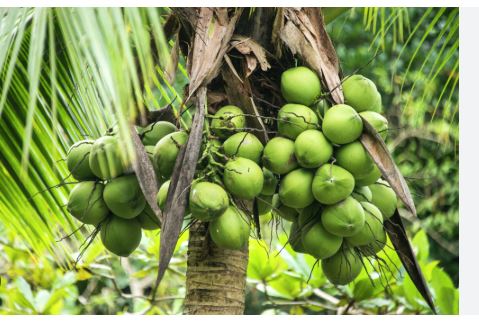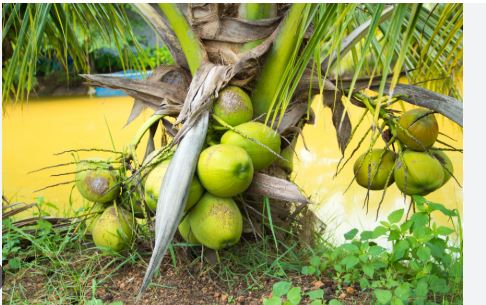
Coconuts, the versatile fruit of the coconut palm (Cocos nucifera), are a tropical treasure, celebrated for their refreshing water, nutrient-rich meat, and myriad uses in food, cosmetics, and crafts. Native to the Indo-Pacific region, these drupes (not true nuts) have spread globally, thriving in coastal tropics from Southeast Asia to the Caribbean. With two primary categories—tall and dwarf—plus numerous hybrids, coconut varieties differ in size, color, flavor, and application.
Their hard, fibrous husks encase refreshing water and nutrient-rich meat, used globally in food, drinks, and cosmetics. These drupes, not true nuts, grow on towering palms, shaping cultures and economies with their diverse applications.
These palms, reaching up to 100 feet, produce clusters of green, yellow, or brown nuts, varying by cultivar. The sweet, hydrating water inside is a natural electrolyte, while the meat yields oil, milk, and flour for cooking and skincare. Dwarf and tall varieties, plus hybrids, offer unique flavors and yields, suiting different climates and uses.
Coconuts are culinary chameleons, starring in dishes from curries to desserts, with their oil prized for high-heat cooking. Beyond food, their husks craft ropes and mats, while shells become bowls and decor. The tree’s leaves and wood build homes, showcasing its “tree of life” status in tropical communities.
Ecologically, coconut palms stabilize coastlines and support biodiversity, though pests like lethal yellowing threaten crops. Sustainable farming is vital to protect these invaluable trees. Their global trade, from fresh nuts to processed goods, underscores their economic importance, fueling livelihoods in tropical regions.

Types of Coconuts
West Coast Tall
The West Coast Tall, a dominant cultivar in India’s coastal regions, grows to 50-90 feet and thrives in diverse soils, from sandy loams to laterites. Producing 80-90 medium-sized coconuts annually after 7-8 years, its nuts vary in color from green to brown. Known for high oil content (65%), the copra is ideal for cooking and cosmetics. Its resilience to pests and saline conditions makes it a staple in states like Kerala and Tamil Nadu, where it’s a cultural icon.
East Coast Tall
East Coast Tall, prevalent in India’s eastern states like Odisha, reaches 50-80 feet and yields 60-70 coconuts per year after 6-8 years. Its medium-to-large nuts, green to yellow, are rich in oil (64%) and used for culinary purposes. Thriving in loamy soils, this variety tolerates coastal winds and moderate pests, making it a reliable choice for farmers. Its adaptability supports its widespread cultivation along India’s eastern seaboard.
Malayan Yellow Dwarf
The Malayan Yellow Dwarf, originating in Malaysia in the 1800s, grows to 20-50 feet and bears pale yellow-green nuts that mature to yellow. Producing 50-70 small, oblong nuts annually after 3-4 years, it’s prized for sweet, hydrating water. Found in Thailand, Brazil, and Fiji, its tender flesh suits desserts and smoothies. This drought-sensitive dwarf is popular for home gardens due to its early fruiting and vibrant color.
Malayan Green Dwarf
Malayan Green Dwarf, a Pacific native, grows to 20-40 feet and produces vibrant green nuts, ideal for drinking at 6-8 months. Yielding 50-70 small nuts per year after 3 years, its water is sweet (7-8% sugar), and the soft flesh is perfect for fresh consumption. Common in Indonesia and the Philippines, it thrives in well-drained soils but is susceptible to drought, making it a favorite for small-scale farmers.
Fiji Dwarf (Niu Leka)
The Fiji Dwarf, or Niu Leka, a short-statured palm (6-9 meters), is renowned for its disease resistance, particularly to lethal yellowing. Native to Fiji, it yields 50-70 small nuts annually after 3-4 years, with green to yellow husks. Its lush canopy and durable nature suit ornamental gardening, while its sweet water and tender meat are ideal for drinking and eating raw. It thrives in tropical climates like Florida.
King Coconut
King Coconut, native to Sri Lanka, grows to 20 meters and produces vibrant orange, football-shaped nuts, 20-30 cm long. Yielding 20-30 nuts per bunch after 6-7 years, its sweet water (6.5-7% sugar) is a street drink staple in Sri Lanka and India. The soft flesh is used in desserts, and the tree’s cultural significance as the “tree of life” elevates its status in tropical economies.
Macapuno
Macapuno, a mutant dwarf from the Philippines, grows to 15-20 meters and bears nuts with jelly-like, soft flesh instead of solid meat due to abnormal endosperm growth. Producing 50-70 nuts after 3-4 years, it’s used in desserts like halo-halo, lacking significant water content. Rare and prized, it requires intensive care and thrives in humid, tropical soils, making it a delicacy in Filipino cuisine.
Kopyor Coconut
Kopyor Coconut, an Indonesian dwarf variant, is similar to Macapuno, with gel-like flesh and minimal water. Growing to 10-15 meters, it yields 50-60 nuts after 3 years, prized for boosting stamina and treating ailments like dengue fever. Its tender, sweet flesh is a culinary gem in specialty markets. Found in rural Indonesia, it thrives in well-drained soils but is rare due to its mutant nature.
Chowghat Orange Dwarf
Chowghat Orange Dwarf, a South Indian variety, grows to 15-20 meters and bears orange-hued nuts. Yielding 50-70 small nuts after 3 years, its water is sweet, and the flesh is soft, ideal for drinking and fresh consumption. Thriving in Tamil Nadu and Kerala’s loamy soils, it’s drought-sensitive but popular for its early fruiting and high oil content (65%), used in local dishes.
Chowghat Green Dwarf
Chowghat Green Dwarf, another Indian favorite, reaches 15-20 meters and produces green nuts with sweet water (7-7.5% sugar). Yielding 50-70 nuts after 3-4 years, it’s ideal for drinking and culinary uses. Grown in Karnataka and Kerala, it prefers well-drained soils and is less pest-resistant than tall varieties. Its tender meat suits smoothies and desserts, making it a gardener’s choice.
Panama Tall
Panama Tall, native to Panama and the Pacific, grows to 60-90 feet with an umbrella-shaped canopy. Producing 60-80 large nuts after 6-8 years, its nuts are green to brown with high oil content (65%), ideal for cooking. Resistant to pests and harsh climates, it thrives in hardiness zones 10-11, making it a robust choice for tropical farmers and gardeners.
Maypan Hybrid
The Maypan Hybrid, a cross between Malayan Dwarf and Panama Tall, grows to 20-50 meters and yields 80-100 medium-to-large nuts after 4 years. Resistant to lethal yellowing, it produces sweet water and nutrient-rich meat, perfect for drinking and cooking. Its adaptability to various soils and climates makes it a commercial favorite in tropical regions like the Caribbean.
Tiptur Tall
Tiptur Tall, a South Indian variety, grows to 50-80 feet and yields 70-80 coconuts annually after 6-7 years. Its leathery fronds produce 6-12-inch nuts, green to brown, with high oil content (65%) for culinary and cosmetic use. Thriving in Karnataka’s loamy soils, it’s low-maintenance and moderately pest-resistant, making it ideal for home gardeners and commercial farms.
Golden Malayan Dwarf
Golden Malayan Dwarf, imported from Indonesia to Bulgaria, grows to 50-60 feet and bears golden-orange nuts. Producing 50-70 large nuts after 3-4 years, its sweet water and flavorful meat are ideal for drinking and cooking. Requiring warm, sheltered conditions outside tropics, its striking color and high yield make it a gardener’s favorite for ornamental and culinary use.
Green Siamese Coconut
Green Siamese Coconut, a Mekong Delta staple, grows to 15-20 meters and yields 140-150 green nuts annually after 3-4 years. Its thin shell and sweet water (7-7.5% sugar) make it Vietnam’s top drinking coconut, with 350 ml per fruit. The soft meat suits desserts, and its high yield supports local economies, often sold fresh or canned.
Dwarf Siamese Coconut
Dwarf Siamese Coconut, grown in Vietnam’s Ben Tre and Tien Giang, reaches 10-15 meters and produces over 150 light green nuts per year after 3 years. Its thin shell yields 250-350 ml of sweet water (7-7.5% sugar), ideal for drinking. Less common than Green Siamese, its high productivity and soft flesh make it a local favorite for fresh consumption.
Red Siamese Coconut
Red Siamese Coconut, a Vietnamese variety, grows to 15-20 meters and yields 100-120 reddish-brown nuts after 3-4 years. With sweet water (7-7.5% sugar) and meat used for oil, cakes, and jams, it’s a versatile export crop. Its shells are crafted into handicrafts, adding economic value. Thriving in Mekong Delta soils, it’s a cultural and culinary asset.
Siamese Fire Coconut
Siamese Fire Coconut, named for its orange-yellow shell, grows to 15-20 meters in Vietnam and yields 140-150 small nuts after 3 years. Its sweet water (6.5-7% sugar) and 250-300 ml volume make it ideal for drinking and ecotourism coconut gardens. The soft meat suits desserts, and its vibrant color attracts tourists, boosting local markets.
Kelapa Gading (Ivory Coconut)
Kelapa Gading, or Ivory Coconut, a dwarf Indonesian variety, grows to 10-15 meters and bears pale ivory nuts. Yielding 50-70 nuts after 3 years, its sweet water offers health benefits like toxin neutralization. Found in rural rice fields, its shells are used in handicrafts. Its early fruiting and affordability make it a community staple.
Kelapa Hijau (Green Coconut)
Kelapa Hijau, an Indonesian green coconut, grows to 15-20 meters and produces vibrant green nuts harvested young for drinking. Yielding 50-70 nuts after 3-4 years, its water is prized for treating food poisoning, and its fibers craft household items. Thriving in tropical soils, its health benefits and versatility make it a culinary favorite.
Kelapa Pandan
Kelapa Pandan, an Indonesian dwarf, reaches 3 meters and yields 50-70 nuts after 3 years. Its pandan-leaf aroma enhances its sweet water, making it a culinary delight for beverages and desserts. Expensive due to intensive care, its small stature suits small farms. Found in Indonesia’s specialty markets, it’s a rare, flavorful gem.
Kelapa Genjah Entok
Kelapa Genjah Entok, an Indonesian dwarf, grows to 10-15 meters and yields 60-80 green to yellow nuts after 3 years. Its sweet water and tender meat are ideal for drinking and fresh eating. Thriving in well-drained soils, its early fruiting and high yield make it a farmer’s choice in Indonesia’s tropical regions.
Kelapa Merah Wulung
Kelapa Merah Wulung, a rare Indonesian variety, grows to 15-20 meters and produces reddish nuts after 3-4 years. Yielding 50-70 nuts, its sweet water and soft flesh are used in local dishes. Its striking color and cultural significance make it a specialty market favorite, thriving in humid, tropical climates.
VHC1 Hybrid
VHC1 Hybrid, a cross of East Coast Tall and Malayan Dwarf, grows to 20-50 meters and yields 80-100 nuts after 4 years. Its high oil content (65%) and sweet water make it ideal for cooking and drinking. Resistant to pests, it thrives in India’s coastal soils, supporting commercial production with its robust yield and quality.